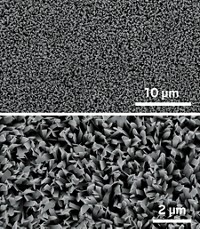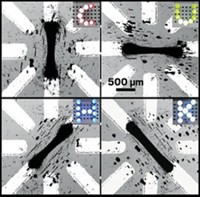Advertisement
Grab your lab coat. Let's get started
Welcome!
Welcome!
Create an account below to get 6 C&EN articles per month, receive newsletters and more - all free.
It seems this is your first time logging in online. Please enter the following information to continue.
As an ACS member you automatically get access to this site. All we need is few more details to create your reading experience.
Not you? Sign in with a different account.
Not you? Sign in with a different account.
ERROR 1
ERROR 1
ERROR 2
ERROR 2
ERROR 2
ERROR 2
ERROR 2
Password and Confirm password must match.
If you have an ACS member number, please enter it here so we can link this account to your membership. (optional)
ERROR 2
ACS values your privacy. By submitting your information, you are gaining access to C&EN and subscribing to our weekly newsletter. We use the information you provide to make your reading experience better, and we will never sell your data to third party members.
Microfluidics
Microrobots move cells
Tiny tools powered by optoelectronic tweezers manipulate targets
by Celia Henry Arnaud
July 12, 2019
| A version of this story appeared in
Volume 97, Issue 28

Microrobots can help manipulate objects too small or delicate for humans to grasp, but the robots themselves must be controlled with dexterity. Aaron R. Wheeler of the University of Toronto and coworkers have now shown that optoelectronic tweezers (OET) can be used to control microrobots of various shapes (Proc. Natl. Acad. Sci. U.S.A. 2019, DOI: 10.1073/pnas.1903406116). Shining light on a photosensitive substrate in OET generates virtual electrodes that produce a nonuniform electric field. The electric field can exert a force via the so-called dielectrophoretic effect and manipulate tiny objects, such as the microrobots. The force produced by OET is stronger than forces produced by conventional optical tweezers. OET is typically used to directly manipulate objects of interest. But using the robots as mediators is faster and less damaging to fragile objects, such as cells, than direct OET. Using the indirect approach, the researchers were able to maneuver the robots around obstacles, such as cellular debris. They used the robots to isolate and transport cells, fuse them, and subject them to RNA sequencing. Such robots “will be particularly useful for transporting objects that are hard to move by exerting force directly,” says Ming C. Wu of the University of California, Berkeley, the inventor of OET.




Join the conversation
Contact the reporter
Submit a Letter to the Editor for publication
Engage with us on Twitter